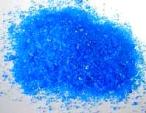WHAT IS SHOCK CHLORINE
Shock chlorine is the common name for Calcium hypochlorite, a powder chemical with the formula Ca(ClO)2. It is widely used for water treatment and as a bleaching agent (bleaching powder). This chemical is considered to be relatively stable and has greater available chlorine (65%) than sodium hypochlorite (liquid bleach).
- Other names: Hypochlorous acid, calcium salt / Bleaching powder / Calcium Oxychloride, shock chlorine
- CAS No: 7778–54–3
- EC No: 231–908–7
- UN No: 1748
- Appearance: white or grey/white powder with odour of chlorine
- Molar Mass: 142.98 g/mol
- Density: 2.35 g/cm3
- Melting Point: 100oC
Uses for Shock chlorine
SHOCK CHLORINE FOR USE IN SWIMMING POOLS & SPAS:
Calcium hypochlorite is used for the disinfection of drinking water or swimming pool water. For use in outdoor swimming pools, calcium hypochlorite can be used as a sanitizer in combination with a cyanuric acid stabilizer. The stabilizer will reduce the loss of chlorine because of UV radiation. Calcium does make the water hard and tends to clog up some filters. However, some types of calcium hypochlorite do contain anti-scaling agents in order to prevent clogging up of pipes/filters. This grade of calcium hypochlorite can also be used in hard waters. The main advantage of calcium hypochlorite is that it is unstabilised unlike chlorinated isocyanurates such as sodium dichloroisocyanurate or trichloroisocyanuric acid. Latter products do contain cyanuric acid. If the level of cyanuric acid becomes too high, it will influence the performance of the chlorine.
Pools running on calcium hypochlorite should have a chlorine level of 1–2 ppm (mg/L).
Calcium hypochlorite is also used for bleaching cotton and linen and is used in the manufacture of chloroform.
For whitening in laundry one normally uses approx 200mls of 5% bleach per load. As the calcium hypochlorite is 65% chlorine then you will need around 15g of the calcium hypochlorite per wash. alternatively you can make a 5% solution by adding 77g of calcium hypochlorite to 1 litre of water and use 200mls of this solution.
Other uses are:
- As a bathroom cleaner
- For Cleaning secondhand items
- Adds glow to glass dishware
- As a Household disinfectant spray
- It remove moss and algae from paths, patios and driveways
- Use to sanitize garden tools
- Kills weeds in walkways
- Preserves and keeps cut flowers fresh
- Can be used to Clean garden furniture,
Disinfecting drinking water with Shock Chlorine:
Calcium hypo is used extensively throughout the world to purify drinking water and make it safe. you can either add it directly into water or make up stock solutions to use to treat batches of water. The first is better as stock solutions will deteriorate with time.
As a simple rule of thumb add 0.5g of solid calcium hypochlorite to 100 litres of water (dissolve the 0.5g in about 1 litre of water first and then add this to the 100 litres).
To read an article on how to disinfect water using Calcium Hypochlorite click here.
Health & Safety:
CLASS C: Oxidizing material. CLASS E: Corrosive solid.
R22– Harmful if swallowed. R38– Irritating to skin. R41– Risk of serious damage to eyes.
.
Where to Buy Shock chlorine / Calcium Hypochlorite online in the UK
Where to Buy sodium dichloroisocyanurate / SDIC online
.







